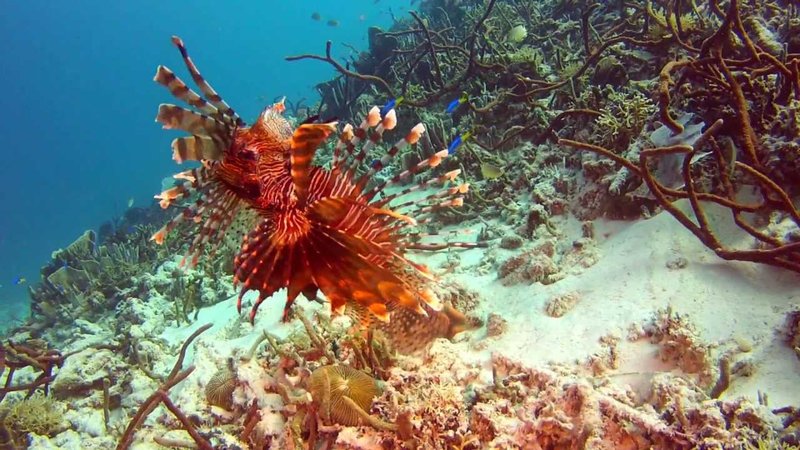
Picture a vibrant underwater world filled with colorful coral and fish darting about. Now, imagine a pair of lionfish, their majestic fins fanned out, dancing in this aquatic playground. Captive breeding can help reduce the pressure on wild populations and provide a unique opportunity for enthusiasts to watch these beautiful fish thrive. So, let’s explore the ins and outs of breeding lionfish at home.
Understanding Lionfish Behavior
Before you even think about breeding lionfish, you need to get to know them. Lionfish are fascinating creatures that exhibit unique behaviors, especially when it comes to mating. In the wild, they’re known to be solitary hunters, but during breeding season, things change. They become more social and engage in courtship displays that are nothing short of mesmerizing.
These fish generally breed at dusk. When the time is right, a male and female will swim together, performing a synchronized dance. It’s a sight to behold! They release their eggs and sperm into the water column, where fertilization occurs. Here’s the thing: creating the right environment that mimics these natural conditions is crucial for successful breeding in captivity.
When it comes to establishing a breeding pair, you should consider the age and size of your lionfish. Typically, they need to be at least a year old and properly conditioned. That means feeding them a well-balanced diet of live and frozen foods to ensure they are healthy and ready to breed.
Creating the Ideal Environment
Setting up the right environment for breeding lionfish is like designing a cozy home for your family. You want everything to be just right! For lionfish, this means providing ample space and the correct water conditions. A tank of at least 75 gallons is recommended for a breeding pair, allowing them enough space to swim and establish territories.
Water conditions play a major role in their well-being. Aim for a temperature between 78°F and 82°F and maintain a salinity of around 1.020 to 1.025. Regularly test the water quality to ensure parameters like ammonia, nitrite, and nitrate levels are within safe ranges. Believe me, keeping the water clean is essential for the health of your fish.
Additionally, adding hiding spots can help your lionfish feel more secure. Consider placing rocks, caves, or even plants in the tank. This not only provides them with shelter but can also spark their natural behaviors, increasing the chances of successful breeding.
Feeding and Conditioning Your Lionfish
Just like any athlete preparing for a big event, your lionfish need to be well-fed and conditioned. A healthy, balanced diet is crucial, especially if you’re trying to breed them. Offer a mix of live feed, like shrimp or small fish, alongside high-quality frozen foods. This variety not only keeps them interested but ensures they receive essential nutrients.
Conditioning a pair for breeding typically takes a few weeks. Gradually increase the quantity and frequency of feedings during this time. You might notice improved energy levels and interactions between the male and female as they prepare to breed. It’s almost like you’re watching them get ready for their first big dance!
You might be wondering how to identify when they’re ready to mate. Look for signs of courtship, like synchronized swimming and more frequent interactions. These behaviors show that they’ve become interested in each other, paving the way for breeding.
Identifying Egg-Laying and Caring for Fry
When your lionfish do decide to breed, you’ll want to be ready. After the courtship, the female lionfish will release her eggs into the water. This can happen several times within a breeding cycle, which usually occurs every few weeks. The eggs are often buoyant, floating to the surface until they hatch in about 24 to 48 hours.
Once the fry hatch, they’re tiny and will need special care. They’re planktonic at first, which means they’ll need infusoria or specially designed fry food to survive. Providing the right nutrition at this stage is critical, as their growth and survival rates can be heavily influenced by their first few weeks of life.
You’ll also want to keep the fry in a separate tank to avoid predation from adult fish. If possible, use a hatchery or a smaller tank to create a safe space for them to grow. As they develop, you can gradually introduce larger foods, transitioning them to the same diet as adult lionfish.
Common Challenges in Breeding Lionfish
Now, let’s talk about the challenges. Breeding lionfish in captivity isn’t all smooth sailing. One major hurdle is stress. Lionfish can be sensitive to changes in their environment, and stress can lead to health issues or even spawn failure. If your fish seem agitated or excessively hiding, it might be time to review their conditions.
Another challenge is ensuring both fish are compatible. Sometimes, males can be aggressive towards females, especially during breeding. It’s essential to monitor their interactions and be prepared to separate them if aggressive behavior arises. You don’t want to create an environment that feels unsafe for either fish.
Lastly, keep an eye on water quality and tank health. Sudden shifts in temperature, salinity, or water quality can cause stress or illness. Regular testing and maintenance can help prevent these issues, keeping your breeding project on track.
Tips for Success in Lionfish Breeding
So, what can you do to increase your chances of success? Here are some tried-and-true tips:
- Start with healthy fish: Always choose strong, healthy specimens when starting your breeding project.
- Maintain consistent conditions: Keep water quality stable and make gradual changes. Fish prefer stability.
- Observe behavior: Spend time watching your fish. Learn their personalities and interactions to gauge their readiness to breed.
- Have a backup plan: Prepare for potential challenges. Have a separate tank ready for fry and a plan for potentially aggressive pairs.
Breeding lionfish can be a rewarding experience, but it takes dedication and patience. Each step is crucial, from creating a comfortable environment to caring for the fry.
Breeding lionfish in captivity is a journey filled with beauty and challenges. By understanding their behavior, setting up the right environment, and providing proper care, you can increase your chances of success. Remember, like any relationship, it takes time, attention, and a little trial and error. So, if you’re up for the challenge, the gorgeous visuals and fascinating behaviors of breeding lionfish can make it all worth it. Dive in and enjoy the process!

